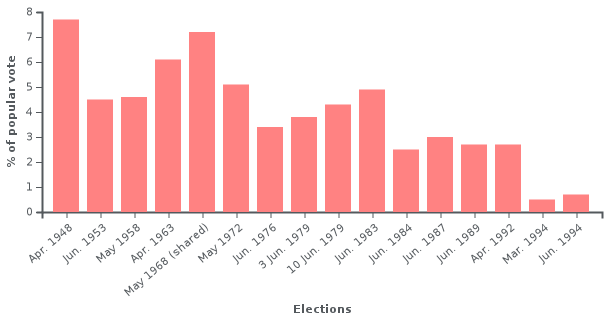Italian Democratic Socialist Party
The Italian Democratic Socialist Party (Italian: Partito Socialista Democratico Italiano, PSDI) was a minor social-democratic[4] political party in Italy. The PSDI, before the 1990s decline in votes and members, had been an important force in Italian politics, being the longest serving partner in government for Christian Democracy. The party's founder and longstanding leader was Giuseppe Saragat, who served as President of the Italian Republic from 1964 to 1971.
Italian Democratic Socialist Party Partito Socialista Democratico Italiano | |
|---|---|
 | |
| Abbreviation | PSDI |
| Leading figures | Giuseppe Saragat Pier Luigi Romita Pietro Longo Franco Nicolazzi Carlo Vizzini |
| Founder | Giuseppe Saragat |
| Founded | 11 January 1947 |
| Dissolved | 10 May 1998 |
| Split from | Italian Socialist Party |
| Merged into | Italian Democratic Socialists |
| Headquarters | Largo Toniolo, 16 Rome |
| Newspaper | L'Umanità |
| Ideology | Social democracy |
| Political position | Centre[1] to centre-left[1][2] |
| National affiliation | Centrism (1947–58) Organic Centre-left (1962–76) Unified Socialist Party (1966–71) Pentapartito (1980–93)[3] |
| European affiliation | Party of European Socialists (1992–94) |
| International affiliation | Socialist International |
| European Parliament group | Party of European Socialists (1979–94) Forza Europa (1994–95) |
| Colours | Red (official) Pink (customary) |
History
The years of the First Republic
The party was founded as the Socialist Party of Italian Workers (PSLI) in 1947 by a splinter group of the Italian Socialist Party (PSI), due to the decision of the latter to join the Italian Communist Party (PCI) in the Popular Democratic Front's electoral list for the 1948 general election.
The split, led by Giuseppe Saragat and the sons of Giacomo Matteotti, took the name of Scissione di Palazzo Barberini, from the name of a palace in Rome where it took place. On 1 May 1951 it joined forces with the smaller Unitary Socialist Party and took the name Socialist Party – Italian Section of the Socialist International (PS–SIIS). On 7 January 1952 the PS–SIIS was ultimately renamed "Italian Democratic Socialist Party" (PSDI).
From 1949 to 1965 members of the PSDI held the presidency of the Istituto Nazionale di Previdenza Sociale (INPS).[5]
In 1966 the party joined the PSI to form the Unified Socialist Party, but in 1969, after a dismaying result at the 1968 general election, it left the new unified party, taking the name Unitary Socialist Party (PSU). It returned to the PSDI name in 1971.
In 1980 the party joined Christian Democracy, the Italian Socialist Party, the Italian Republican Party and the Italian Liberal Party in the five-party coalition (Pentapartito) which ruled the country until 1994 (since 1991 without the Republicans). However the party's role in the coalition was minimal and was over-shadowed by the more powerful PSI.
The PSDI was a member of Socialist International and a founder member of the Party of European Socialists (PES). Its members of the European Parliament thus sat within the Socialist Group since 1979.[6][7][8] In 1994 the party was expelled from the PES.[9]
Decline and re-foundation
The PSDI was involved in the corruption scandals known as Tangentopoli and almost disappeared from the political scene. The 1994 general election resulted in an almost overnight decline of the Pentapartito coalition parties and the rise of Silvio Berlusconi-led Forza Italia, which absorbed many PSDI voters. In January 1995 Gian Franco Schietroma was elected national secretary of the party replacing Enrico Ferri, who wanted to join the centre-right Pole of Freedoms. The followers of Ferri left and established the European Liberal Social Democracy and joined the centre-right Christian Democratic Centre.
In 1998 the party, led by Schietroma, finally merged with the Italian Socialists, one of the successor parties of the PSI, to form the Italian Democratic Socialists. By then most members and voters of the party have joined other parties: Forza Italia (as Carlo Vizzini, party leader in 1992–1993), the Christian Democratic Centre (as Enrico Ferri, party leader in 1993–1995) and The Democrats (as Franco Bruno).
The party was re-established in 2004 with the same name, "Italian Democratic Socialist Party", as the continuation of the party of Saragat, so that the new PSDI numbers its congresses in perfect continuity with the late PSDI.
Popular support
.jpg)
The PSDI had its best result at its first appearance in the 1948 general election, when it gained 7.1% of the vote. In that occasion the party was successful in stealing many votes from the Italian Socialist Party, which was damaged by the split as well as by the alliance with the Italian Communist Party in the Popular Democratic Front. The PSDI found its heartlands in Northern Italy: 12.9% in the Province of Turin, 11.9% in Cuneo, 10.6% in Milan, 13.9% in Sondrio, 12.6% in Treviso, 15.9% in Belluno, and 14.9% in Udine.[10]
From 1953 to 1987 the party's support was around 4–5%, with the sole exception of 1963, when it gained 6.1%. In the 1992 general election, the last before Tangentopoli, the PSDI won just 2.7%. The party maintained for decades its strongholds in the North-West and North-East, but since the 1960s it started to gain support in Southern Italy. By 1987 the party's strongholds had moved South, especially Apulia, Campania, Basilicata, Calabria and Sicily,[11] similarly to what also the other parties of Pentapartito (Christian Democrats, Socialists, Republicans and Liberals) were experiencing. This was partly due to the growth of regionalist parties in the North (united in Lega Nord since 1991).
After Tangentopoli, Mani pulite and subsequent political crisis, the PSDI has almost disappeared electorally, although it retains some support locally in the South, especially in Apulia.
The electoral results of PSDI in general (Chamber of Deputies) and European Parliament elections since 1948 are shown in the chart below.

Electoral results
Italian Parliament
| Chamber of Deputies | |||||
| Election year | Votes | % | Seats | +/− | Leader |
|---|---|---|---|---|---|
| 1948 | 1,858,116 (3rd) | 7.7 | 33 / 574 |
||
| 1953 | 1,222,957 (6th) | 4.5 | 14 / 590 |
||
| 1958 | 1,345,447 (5th) | 4.6 | 22 / 596 |
||
| 1963 | 1,876,271 (5th) | 6.1 | 33 / 630 |
||
| 1968 | Into PSU | – | 29 / 630 |
||
| 1972 | 1,718,142 (5th) | 5.1 | 29 / 630 |
||
| 1976 | 1,239,492 (5th) | 3.4 | 29 / 630 |
||
| 1979 | 1,407,535 (5th) | 3.8 | 29 / 630 |
||
| 1983 | 1,508,234 (6th) | 4.9 | 23 / 630 |
||
| 1987 | 1,140,209 (6th) | 3.0 | 17 / 630 |
||
| 1992 | 1,066,672 (10th) | 2.7 | 16 / 630 |
||
| 1994 | 179,495 (14th) | 0.5 | 0 / 630 |
||
| Senate of the Republic | |||||
| Election year | Votes | % | Seats | +/− | Leader |
|---|---|---|---|---|---|
| 1948 | 1,219,287 (3rd) | 5.0 | 10 / 237 |
||
| 1953 | 1,046,301 (6th) | 4.3 | 4 / 237 |
||
| 1958 | 1,136,803 (5th) | 4.4 | 5 / 246 |
||
| 1963 | 1,743,837 (5th) | 6.4 | 14 / 315 |
||
| 1968 | Into PSU | – | 10 / 315 |
||
| 1972 | 1,614,273 (5th) | 5.4 | 11 / 315 |
||
| 1976 | 974,940 (5th) | 3.1 | 6 / 315 |
||
| 1979 | 1,320,729 (5th) | 4.2 | 9 / 315 |
||
| 1983 | 1,184,936 (6th) | 3.8 | 8 / 315 |
||
| 1987 | 822,593 (6th) | 2.5 | 6 / 315 |
||
| 1992 | 853,895 (10th) | 2.6 | 3 / 315 |
||
| 1994 | 66,589 (14th) | 0.2 | 0 / 315 |
||
European Parliament
| European Parliament | |||||
| Election year | Votes | % | Seats | +/− | Leader |
|---|---|---|---|---|---|
| 1979 | 1,514,272 (5th) | 4.3 | 4 / 81 |
||
| 1984 | 1,225,462 (6th) | 3.5 | 3 / 81 |
||
| 1989 | 945,383 (7th) | 2.7 | 2 / 81 |
||
| 1994 | 227,439 (13th) | 0.7 | 1 / 87 |
||
Symbols
 1948-1992
1948-1992 1992–1995
1992–1995
Leadership
- Secretary: Giuseppe Saragat (1947–1948), Alberto Simonini (1948), Ugo Guido Mondolfo (1949), Ludovico D'Aragona (1949), Giuseppe Saragat (1949–1952), Ezio Vigorelli (1952), Giuseppe Romita (1952), Giuseppe Saragat (1952–1954), Gian Matteo Matteotti (1954–1957), Giuseppe Saragat (1957–1964), Mario Tanassi (1964–1966), unification with PSI in the PSU (1966–1969), Mauro Ferri (1969–1972), Mario Tanassi (1972), Flavio Orlandi (1972–1975), Mario Tanassi (1975–1976), Giuseppe Saragat (1976), Pier Luigi Romita (1976–1978), Pietro Longo (1978–1985), Franco Nicolazzi (1985–1988), Antonio Cariglia (1988–1992), Carlo Vizzini (1992–1993), Enrico Ferri (1993–1995), Gian Franco Schietroma (1995–1998)
- President: Giuseppe Saragat (1975–1976),
- Party Leader in the Chamber of Deputies: Giuseppe Modigliani (1947), Rocco Gullo (1947–1948), Mario Langhena (1948–1950), Luigi Benanni (1950–1951), Ezio Vigorelli (1951–1954), Paolo Rossi (1954–1956), Alberto Simonini (1956–1958), Giuseppe Saragat (1958–1963), Virginio Bertinelli (1963–1966), Mario Tanassi (1966), Egidio Ariosto (1966–1969), Flavio Orlandi (1969–1972), Antonio Cariglia (1972–1976), Luigi Preti (1976–1978), Franco Nicolazzi (1978–1979), Alessandro Reggiani (1979–1987), Filippo Caria (1987–1992), Dino Madaudo (1992), Enrico Ferri (1992–1994)
References
- "Il punto sull'attivita' e sulla collocazione politica del PSDI; la olidarieta' del PSDI al digiuno di Marco Pannella contro la disinformazione della RAI in particolar modo sui 13 referendum". RadioRadicale (in Italian). 21 January 1994. Retrieved 5 December 2013.
- Di Alberto Stabile (1 May 1984). "Nicolazzi, L' Anti-Longo Sogna Per Il Psdi Un Futuro A Sinistra". La Repubblica (in Italian). Retrieved 5 December 2013.
- Il Pentapartito – Storia della Repubblica Italiana
- Lawrence Ezrow (2011). "Electoral systems and party responsiveness". In Norman Schofield; Gonzalo Caballero (eds.). Political Economy of Institutions, Democracy and Voting. Springer Science & Business Media. p. 320. ISBN 978-3-642-19519-8.
- A History of Contemporary Italy: Society and Politics, 1943–1988 by Paul Ginsborg
- "Parlement Européen 1979". Europe-politique. Retrieved 5 December 2013.
- "Parlement Européen 1984". Europe-politique. 17 February 2007. Retrieved 5 December 2013.
- "Parlement Européen 1989". Europe-politique. Retrieved 5 December 2013.
- Marina Costa Loba; Pedro C. Magalhães (2004). "The Portuguese Socialists and the Third Way". In Giuliano Bonoli; Martin Powell (eds.). Social Democratic Party Policies in Contemporary Europe. Routledge. p. 84. ISBN 978-1-134-40891-7.
- https://web.archive.org/web/20080626005144/http://elezionistorico.interno.it/area.php?tp=C&dt=18%2F04%2F1948. Archived from the original on 26 June 2008. Retrieved 16 October 2008. Missing or empty
|title=(help) - "Ministero dell'Interno. Archivio Storico delle Elezioni". Elezionistorico. Retrieved 5 December 2013.